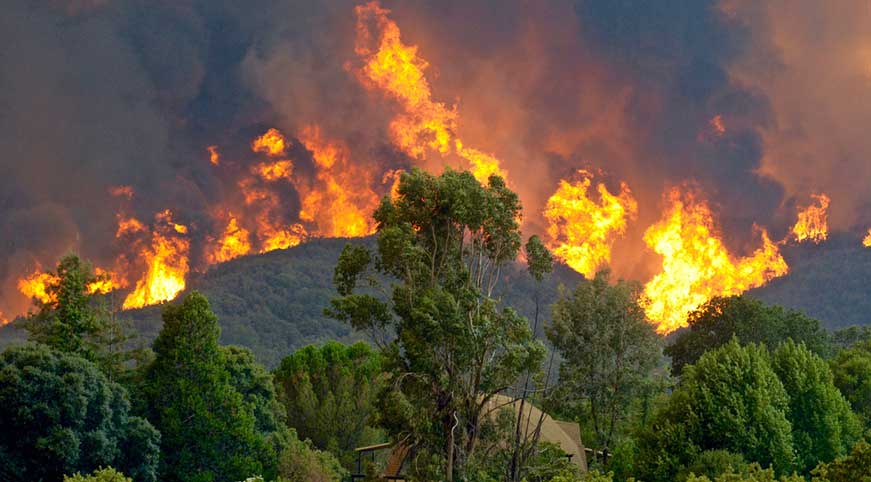Posted by Dr. Kevin Park
The frequency of wildfires in California is increasing, so fire season planning and preparedness have become even more important—not just for those who live in fire-prone areas, but throughout Southern California. The health risks associated with wildfires can extend far beyond the burn areas, so everyone should know the precautions to take to protect your health.
Smoke Inhalation, Particle Pollution and Risks
Wildfire smoke—which consists of invisible toxic gases and residue particles from burning of forest, trees, and plants—can travel long distances and negatively impact the climate and air quality over a widespread region1. Inhaling wildfire smoke can cause a range of health issues among people of all ages.
Smoke inhalation poses short- and long-term health risks for infants, young children, pregnant women, and elderly people with chronic health issues. Short-term or immediate effects of inhaling wildfire smoke include coughing, difficulty breathing, wheezing, eye irritation, headaches, and lung and cardiovascular problems even in healthy people. People with existing health concerns—heart disease, lung disease, asthma, etc.—can experience worsening of their existing symptoms. Repeated exposure can cause prolonged illness such as chronic obstructive pulmonary disease (COPD), lung cancer, and even asthma.
In addition to smoke, wildfires release fine particulate matter—about 30 times smaller than a single hair strand on your head2—into the atmosphere. Though it is invisible to the naked eye, particle pollution can worsen underlying lung conditions.
Preventing and Treating Health Concerns
The best way to prevent smoke inhalation is avoiding exposure and staying indoors. Those with existing health concerns should talk to their doctor or health care provider before fire season to develop an action plan and get emergency medications, such as an inhaler. Even with these precautions, if you are exposed to smoke and ash and experience symptoms, seek immediate care in an emergency room or urgent care.
Monitoring Air Quality
Fire season or not, it is essential to monitor the air quality to protect yourself and your family. AQMD, an air quality monitoring portal, provides a nationwide daily forecast of outdoor air quality and any associated health concerns. By monitoring air quality reports, you can track air quality in real-time and be prepared for days with poor air quality.
As a result of climate change and increasing instances of wildfires, we all need to plan and be prepared so we can avoid serious health problems.
WHO is at risk?
- Infants can develop breathing difficulties
- Young children can develop respiratory problems
- Adults with existing heart or lung disease
- Elderly people with multiple health issues
- Pregnant women
WHAT are the symptoms?
- Common symptoms include irritation in eyes, runny nose, coughing, wheezing, phlegm, headache, and tiredness
- People with heart disease may experience fatigue, difficulty breathing, chest pain, and palpitations
- People with lung disease may experience difficulty breathing, wheezing, coughing, and chest discomfort
HOW to protect yourself?
- Stay indoors and avoid exposure to burning area, smoke, and particles by closing all windows and doors
- Frequently monitor air quality and sign- up for alerts on AQMD
- Consult your doctor to develop an action plan before a wildfire situation, get emergency medication such as asthma inhalers, and understand proper usage
- Keep respirator masks handy to protect yourself from smoke inhalation or exposure to ash and learn proper usage
- Seek emergency care and call your healthcare provider if your symptoms worsen
Source: AirNow, Centers for Diseases Control and Prevention, HPMC
1Liu, J. C., Wilson, A., Mickley, L. J., Dominici, F., Ebisu, K., Wang, Y., Sulprizio, M. P., Peng, R. D., Yue, X., Son, J. Y., Anderson, G. B., … Bell, M. L. (2017). Wildfire-specific Fine Particulate Matter and Risk of Hospital Admissions in Urban and Rural Counties. Epidemiology (Cambridge, Mass.), 28(1), 77-85. Retrieved from https://www.ncbi.nlm.nih.gov/pmc/articles/PMC5130603/#R22
2United States Environmental Protection Agency, “Particulate Matter Basics”, https://www.epa.gov/pm-pollution/particulate-matter-pm-basics
 ENGLISH
ENGLISH KOREAN
KOREAN Spanish
Spanish RUSSIAN
RUSSIAN Armenian
Armenian FILIPINO
FILIPINO Chinese (Simplified)
Chinese (Simplified) Chinese (Traditional)
Chinese (Traditional)


최신댓글